Aztec Art › Aztec Civilization » Ancient origins
Articles and Definitions › Contents
- Aztec Art › Ancient History
- Aztec Civilization › Antique Origins
Ancient civilizations › Historical and archaeological sites
Aztec Art › Ancient History
Definition and Origins
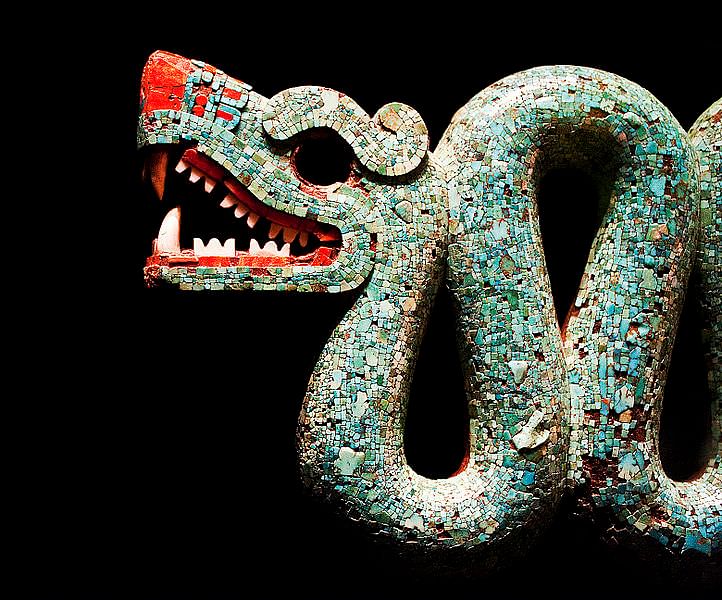
The Aztec Empire, centred at the capital of Tenochtitlan, dominated most of Mesoamerica in the 15th and 16th centuries CE. With military conquest and trade expansion the art of the Aztecs also spread, helping the Aztecs achieve a cultural and political hegemony over their subjects and creating for posterity a tangible record of the artistic imagination and great talent of the artists from this last great Mesoamerican civilization.
INFLUENCES
Common threads run through the history of Mesoamerican art. The Olmec, Maya, Toltec, and Zapotec civilizations, amongst others, perpetuated an artistic tradition which displayed a love of monumental stone sculpture, imposing architecture, highly decorated pottery, geometric stamps for fabric and body art, and breathtaking metalwork which were all used to represent people, animals, plants, gods and features of religious ceremony, especially those rites and deities connected to fertility and agriculture.
Aztec artists were also influenced by their contemporaries from neighbouring states, especially artists from Oaxaca (a number of whom permanently resided at Tenochtitlan) and the Huastec region of the Gulf Coast where there was a strong tradition of three-dimensional sculpture. These diverse influences and the Aztecs' own eclectic tastes and admiration of ancient art made their art one of the most varied of all ancient cultures anywhere. Sculptures of gruesome gods with abstract imagery could come from the same workshop as naturalistic works which depicted the beauty and grace of the animal and human form.
FEATURES OF AZTEC ART
Metalwork was a particular skill of the Aztecs. The great Renaissance artist Albrecht Drurer saw some of the artefacts brought back to Europe which caused him to say, '...I have never seen in all my days that which so rejoiced my heart, as these things.For I saw among them amazing artistic objects, and I marvelled over the subtle ingenuity of the men in these distant lands'.Unfortunately, as with most other artefacts, these objects were melted down for currency, and so very few examples survive of the Aztecs' fine metalworking skills in gold and silver. Smaller items have been discovered, amongst them gold labrets (lip piercings), pendants, rings, earrings and necklaces in gold representing everything from eagles to tortoise shells to gods, which are testimony to the skills in lost-wax casting and filigree work of the finest artisans or tolteca.
THE AZTECS ALSO EMPLOYED ART AS A TOOL TO REINFORCE THEIR MILITARY AND CULTURAL DOMINANCE ACROSS MESOAMERICA.
Aztec sculpture has been a better survivor, and its subject was very often individuals from the extensive family of gods they worshipped. Carved in stone and wood these figures, sometimes monumental in size, were not idols containing the spirit of the god, as in Aztec religion the spirit of a particular deity was thought to reside in sacred bundles kept within shrines and temples. However, it was thought necessary to 'feed' these sculptures with blood and precious objects, hence tales from the Spanish conquistadors of huge statues splattered with blood and encrusted with jewels and gold. Other large sculptures, more in the round, include the magnificent seated god Xochipilli and the various chacmools, reclining figures with a hollow carved in the chest which was used as a receptacle for the hearts of sacrificial victims. These, as with most other Aztec sculpture, would have once been painted using a wide range of bright colours.
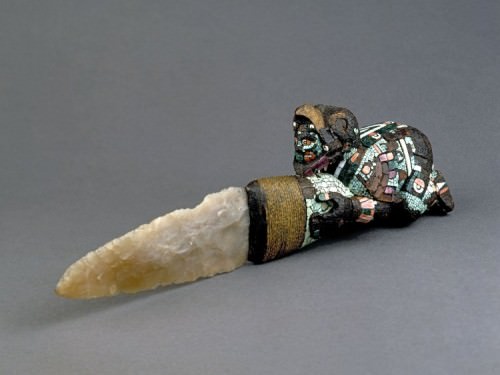
Aztec Ceremonial Knife
Miniature work was also popular where subjects such as plants, insects, and shells were rendered in precious materials such as carnelite, pearl, amethyst, rock crystal, obsidian, shell, and the most highly valued of all materials, jade. One other material which was highly prized was exotic feathers, especially the green plumage of the quetzal bird. Feathers cut up into small pieces were used to create mosaic paintings, as decoration for shields, costumes and fans, and in magnificent headdresses such as the one ascribed to Motecuhzoma II which is now in the Museum für Völkerkunde in Vienna.
Turquoise was a particularly favoured material with Aztec artists, and the use of it in mosaic form to cover sculpture and masks has created some of the most striking imagery from Mesoamerica. A typical example is the decorated human skull which represents the god Tezcatlipoca and which now resides in the British Museum, London. Another fine example is the mask of Xiuhtecuhtli, the god of fire, with sleepy-looking mother-of-pearl eyes and a perfect set of white conch shell teeth. Finally, there is the magnificent double-headed snake pectoral, also now in the British Museum. With carved cedar wood completely covered in small squares of turquoise and the red mouths and white teeth rendered in spondylus and conch shell respectively, the piece was probably once part of a ceremonial costume. The snake was a potent image in Aztec art as the creature, able to shed its skin, represented regeneration and was also particularly associated with the god Quetzalcoatl.
Despite the absence of the potter's wheel, the Aztecs were also skilled with ceramics as indicated by large hollow figures and several beautifully carved lidded-urns which were excavated by the side of the Templo Mayor at Tenochtitlan, probably used as receptacles for funeral ashes. Other examples of ceramic works are the moulded censers with tripod legs from Texcoco, spouted jugs, and elegant hourglass-shaped cups. These vessels are typically thin-walled, well proportioned, have a cream or red and black slip, and carry finely painted geometric designs in earlier designs and flora and fauna in later examples. The most highly-prized ceramics by the Aztecs themselves, and the type which Motecuhzoma himself used, were the ultra-thin Cholula ware from Cholollan in the Valley of Puebla. Vessels could also be made from moulds or carved while the clay was still leather-hard. A fine example of these anthropomorphic vessels is the celebrated vase representing the head of the rain god Tlaloc painted a bright blue, with goggle eyes and fearsome red fangs, now in the National Museum of Anthropology in Mexico City.

Tlaloc
Musical instruments were another important part of the Aztec artist's repertoire. These included ceramic flutes and wooden teponaztlis and huehuetls, respectively, long and upright ceremonial drums. They are richly decorated with carvings, and one of the finest is the Malinalco drum which is covered in dancing jaguars and eagles who represent sacrificial victims as indicated by banners and speech scrolls of warfare and fire symbols.
ART AS PROPAGANDA
The Aztecs, as with their cultural predecessors, employed art as a tool to reinforce their military and cultural dominance.Imposing buildings, frescoes, sculpture and even manuscripts, especially at such key sites as Tenochtitlan, not only represented and even replicated the key elements of Aztec religion, but they also reminded subject peoples of the wealth and power which permitted their construction and manufacture.
The supreme example of this use of art as a conveyor of political and religious messages is the Templo Mayor at Tenochtitlan which was much more than a hugely impressive pyramid. It was carefully designed in every detail to represent the sacred snake mountain of the earth Coatepec, so important in Aztec religion and mythology. This mountain was the site where Coatlicue (the earth) gave birth to her son Huitzilopochtli (the sun), who defeated the other gods (the stars) led by his sister Coyolxauhqui (the moon). A temple to Huitzilopochtli was built on top of the pyramid along with another in honour of the rain god Tlaloc. Further associations with the myth are the snake sculptures lining the base and the Great Coyolxauhqui Stone carved in c. 1473 CE, also found at the base of the pyramid and which represents in relief the dismembered body of the fallen goddess. The stone, along with other such sculptures as the Tizoc Stone, related this cosmic imagery to the contemporary defeat of local enemies. In the case of the Coyolxauhqui Stone, the defeat of the Tlatelolca is being referenced. Finally, the Templo Mayor was itself a repository of art as, when its interior was explored, a vast hord of sculpture and art objects were discovered entombed with the remains of the dead and these pieces are, in many cases, works that the Aztecs had themselves collected from more ancient cultures than their own.
Temples extolling the Aztec view of the world were also constructed in conquered territories. The Aztecs usually left existing political and administrative structures in place, but they did impose their own gods in a hierarchy above local deities, and this was largely done through architecture and art, backed up with sacrificial ceremonies at these new sacred places, typically constructed on previous sacred sites and often in spectacular settings such as on mountain peaks.
Aztec imagery which spread across the empire includes many lesser known deities than Huitzilopochtli and there are a surprising number of examples of nature and agricultural gods. Perhaps the most famous are the reliefs of the water goddess Chalchiuhtlicue on the Malinche Hill near ancient Tula. These and other works of Aztec art were most often made by local artists and may have been commissioned by authorities representing the state or by private colonists from the Aztec heartland.Architectural art, rock carvings of gods, animals and shields, and other art objects have been found across the empire from Puebla to Veracruz and especially around cities, hills, springs, and caves. Further, these works are usually unique, suggesting the absence of any organised workshops.

Tizoc Stone
MASTERPIECES
The large circular Stone of Tizoc (carved in c. 1485 CE from basalt) is a masterful mix of cosmic mythology and real-world politics. It was originally used as a surface on which to perform human sacrifice and as these victims were usually defeated warriors it is entirely appropriate that the reliefs around the edge of the stone depict the Aztec ruler Tizoc attacking warriors from the Matlatzinca, an area conquered by Tizoc in the late 15th century CE. The defeated are also portrayed as Chichimecs ie landless barbarians, whilst the victors wear the noble dress of the revered ancient Toltec. The upper surface of the stone, 2.67 m in diameter, depicts an eight-pointed sun-disk. The Stone of Tizoc now resides in the National Museum of Anthropology in Mexico City.
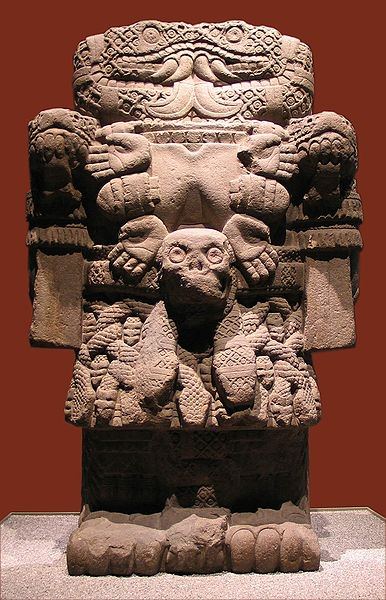
Coatlicue
The massive basalt statue of Coatlicue (carved in the final half century of Aztec rule) is widely considered one of the finest examples of Aztec sculpture. The goddess is presented in terrifying form with two snake heads, clawed feet and hands, a necklace of dismembered hands and human hearts with a skull pendant, and wearing a skirt of writhing snakes. Perhaps one of a group of four and representing the revelation of female power and terror, the 3.5 m high statue leans slightly forward so that the overall dramatic effect of the piece is so emotive that it is understandable why the statue was actually re-buried several times following its original excavation in 1790 CE. The statue of Coatlicue now resides in the National Museum of Anthropology in Mexico City.
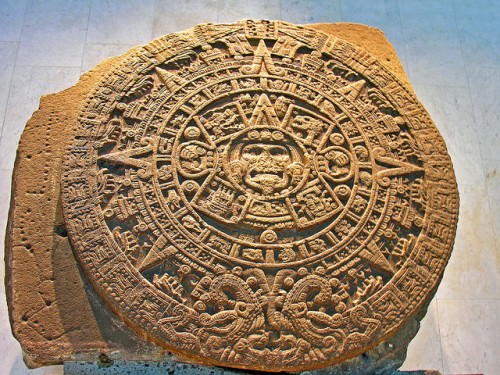
Aztec Sun Stone
The Sun Stone, also known as the Calendar Stone (despite the fact that it is not a functioning calendar), must be the most recognisable art object produced by any of the great civilizations of Mesoamerica. Discovered in the 18th century CE near the cathedral of Mexico City, the stone was carved c. 1427 CE and shows a solar disk which presents the five consecutive worlds of the sun from Aztec mythology. The basalt stone is 3.78 m in diameter, almost a metre thick and was once part of the Templo Mayor complex of Tenochtitlan. At the centre of the stone is a representation of either the sun god Tonatiuh (the Day Sun) or Yohualtonatiuh (the Night Sun) or the primordial earth monster Tlaltecuhtli, in the latter case representing the final destruction of the world when the 5th sun fell to earth. Around the central face at four points are the other four suns which successively replaced each other after the gods Quetzalcoatl and Tezcatlipoca struggled for control of the cosmos until the era of the 5th sun was reached. On either side of the central face are two jaguar heads or paws, each clutching a heart, representing the terrestrial realm. The two heads at the bottom centre represent fire serpents, and their bodies run around the perimeter of the stone with each ending in a tail. The four cardinal and the inter-cardinal directions are also indicated with larger and lesser points respectively.
As one final example of the wealth of Aztec art which has survived the best destructive efforts of their conquerors, there is the life-sized eagle warrior from Tenochtitlan. The figure, seemingly about to take flight, is in terracotta and was made in four separate pieces. This Eagle Knight wears a helmet representing the bird of prey, has wings and even clawed feet. Remains of stucco suggest that the figure was once covered in real feathers for an even more life-like effect. Originally, it would have stood with a partner, either side of a doorway.
CONCLUSION
Following the fall of the Aztec Empire the production of indigenous art went into decline. However, some Aztec designs lived on in the work of local artists employed by Augustinian friars to decorate their new churches during the 16th century CE.Manuscripts and feather paintings also continued to be produced, but it was not until the late 18th century CE that an interest in Precolumbian art and history would lead to a more systematic investigation of just what lay under the foundations of modern Mexican cities. Slowly, an ever-growing number of Aztec artefacts have revealed, in case there had ever been any doubt, proof-positive evidence that the Aztecs were amongst the most ambitious, creative, and eclectic artists that Mesoamerica had ever produced.
Aztec Civilization › Antique Origins
Definition and Origins
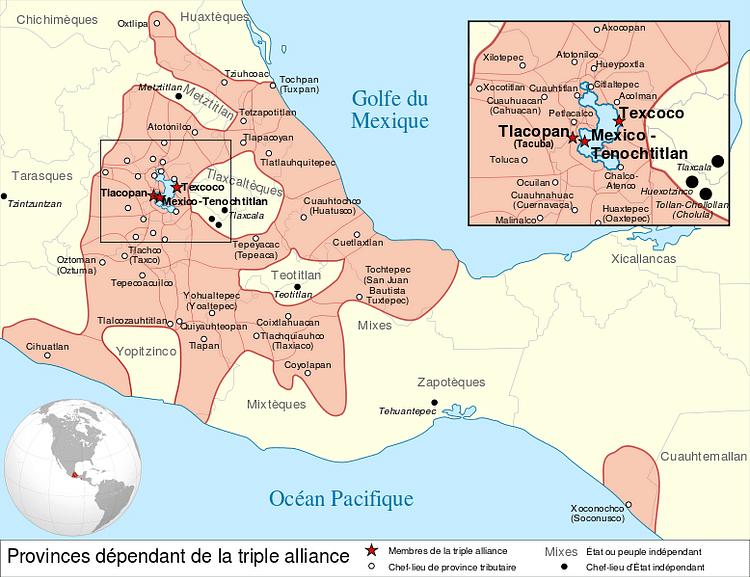
The Aztec Empire flourished between c. 1345 and 1521 CE and, at its greatest extent, covered most of northern Mesoamerica. Aztec warriors were able to dominate their neighbouring states and permit rulers such as Motecuhzoma II to impose Aztec ideals and religion across Mexico. Highly accomplished in agriculture and trade, the last of the great Mesoamerican civilizations was also noted for its art and architecture which ranks amongst the finest ever produced on the continent.
The Aztec state is actually the most well documented Mesoamerican civilization with sources including archaeology, native books (codices) and lengthy and detailed accounts from their Spanish conquerors - both by military men and Christian clergy.These latter sources may not always be reliable but the picture we have of the Aztecs, their institutions, religious practices, warfare and daily life is a rich one and it continues to be constantly expanded with details being added through the endeavours of 21st century CE archaeologists and scholars.
HISTORICAL OVERVIEW
Sometime around 1100 CE the city -states or altepetl which were spread over central Mexico began to compete with each other for local resources and regional dominance. Each state had its own ruler or tlatoani who led a council of nobles but these small urban centres surrounded by farmland soon sought to expand their wealth and influence so that by c. 1400 CE several small empires had formed in the Valley of Mexico. Dominant amongst these were Texcoco, capital of the Acholhua region, and Azcapotzalco, capital of the Tepenec. These two empires came face to face in 1428 CE with the Tepanec War. The Azcapotzalco forces were defeated by an alliance of Texcoco, Tenochtitlan (the capital of the Mexica) and several other smaller cities. Following victory a Triple Alliance was formed between Texcoco, Tenochtitlan and a rebel Tepanec city, Tlacopan. A campaign of territorial expansion began where the spoils of war - usually in the form of tributes from the conquered - were shared between these three great cities. Over time Tenochtitlan came to dominate the Alliance, its ruler became the supreme ruer - the huey tlatoque ('high king') - and the city established itself as the capital of the Aztec empire.
MASTERS OF THE WORLD, THEIR EMPIRE SO WIDE AND ABUNDANT THAT THEY HAD CONQUERED ALL THE NATIONS. DIEGO DURÁN
The empire continued to expand from 1430 CE and the Aztec military - bolstered by conscription of all adult males, men supplied from allied and conquered states, and such elite groups as the Eagle and Jaguar warriors - swept aside their rivals.Aztec warriors wore padded cotton armour, carried a wooden or reed shield covered in hide, and wielded weapons such as a super sharp obsidian sword-club ( macuahuitl ), a spear or dart thrower ( atlatl ), and bow and arrows. Elite warriors also wore spectacular feathered and animal skin costumes and headdresses to signify their rank. Battles were concentrated in or around major cities and when these fell the victors claimed the whole surrounding territory. Regular tributes were extracted and captives were taken back to Tenochtitlan for ritual sacrifice. In this way the Aztec empire came to cover most of northern Mexico, an area of some 135,000 square kilometres.
The empire was kept together through the appointment of officials from the Aztec heartland, inter-marriages, gift-giving, invitations to important ceremonies, the building of monuments and artworks which promoted Aztec imperial ideology, and most importantly of all, the ever-present threat of military intervention. Some states were integrated more than others whilst those on the extremities of the empire became useful buffer zones against more hostile neighbours, notably the Tarascan civilization.
TENOCHTITLAN
The Aztec capital of Tenochtitlan on the western shore of Lake Texcoco flourished so that the city could boast at least 200,000 inhabitants by the early 16th century CE, making it the largest city in the Pre-Columbian Americas. These inhabitants were divided into several social strata. At the top were local rulers ( teteuhctin ), then came nobles ( pipiltin ), commoners ( macehualtin ), serfs ( mayeque ), and finally slaves ( tlacohtin ). The strata seem to have been relatively fixed but there is some evidence of movement between them, especially in the lower classes.

Temple Mayor, Tenochtitlan
Not only the political and religious capital, Tenochtitlán was also a huge trading centre with goods flowing in and out such as gold, greenstone, turquoise, cotton, cacao beans, tobacco, pottery, tools, weapons, foodstuffs (tortillas, chile sauces, maize, beans, and even insects, for example) and slaves. The Spanish invaders were hugely impressed by the city's splendour and magnificent architecture and artwork, especially the Templo Mayor pyramid and massive stone sculptures. Dominating the city was the huge Sacred Precinct with its temples and monumental ball court. Tenochtitlan's water management was also impressive with large canals criss-crossing the city which was itself surrounded by chinampas - raised and flooded fields - which greatly increased the agricultural capacity of the Aztecs. There were also anti-flood dykes, artificial reservoirs for fresh water, and wonderful flower gardens dotted around the city.
The whole city was designed to inspire awe in the people, especially visiting nobles who, entertained with lavish ceremonies, could see that the Mexica Aztecs truly were:
Masters of the world, their empire so wide and abundant that they had conquered all the nations and that all were their vassals. The guests, seeing such wealth and opulence and such authority and power, were filled with terror. (Diego Durán, the Spanish friar, quoted in Nichols, 451)
RELIGION
Mythology and religion, as with most ancient cultures, were closely intertwined for the Aztecs. The very founding of Tenochtitlán was based on the belief that peoples from the mythical land of plenty Aztlán (literally 'Land of White Herons' and origin of the Aztec name) in the far northwest had first settled in the Valley of Mexico. They had been shown the way by their god Huitzilopochtli who had sent an eagle sitting on a cactus to indicate exactly where these migrants should build their new home. The god also gave these people their name, the Mexica, who along with other ethnic groups, who similarly spoke Nahuatl, collectively made up the peoples now generally known as the Aztecs.
The Aztec pantheon included a mix of older Mesoamerian gods and specifically Mexica deities. The two principal gods worshipped were Huitzilopochtli (the war and sun god) and Tlaloc (the rain god) and both had a temple on top of the Templo Mayor pyramid at the heart of Tenochtitlan. Other important gods were Quetzalcoatl (the feathered serpent god common to many Mesoamerican cultures), Tezcatlipoca (supreme god at Texcoco), Xipe Totec (god of Spring and agriculture), Xiuhtecuhtli (god of fire), Xochipilli (god of summertime and flowers), Ometeotl (the creator god), Mictlantecuhtli (god of the dead) and Coatlicue (the earth-mother goddess).

Quetzalcoatl
This sometimes bewildering array of gods presided over every aspect of the human condition. The timing of ceremonies in honour of these deities was dictated by a variety of calendars. There was the 260-day Aztec calendar which was divided into 20 weeks, each of 13 days which carried names such as Crocodile and Wind. There was also a Solar calendar consisting of 18 months, each of 20 days. The 584 day period covering the rise of Venus was also important and there was a 52 year cycle of the sun to be considered. The movement of planets and stars were carefully observed (albeit not as accurately, though, as the Maya had done) and they provided the motive for the specific timing of many religious rites and agricultural practices.
The sun, not surprisingly, had great significance for the Aztecs. They believed that the world went through a series of cosmic ages, each had its own sun but finally each world was destroyed and replaced by another until the fifth and final age was reached - the present day for the Aztecs. This cosmic progression was wonderfully represented in the famous Sun Stone but also crops up in many other places too.
The gods were honoured with festivals, banquets, music, dancing, decoration of statues, burning of incense, the ritual burial of precious goods, penances such as blood-letting, and animal sacrifices. Humans, both adults and less often children, were also frequently sacrificed to metaphorically 'feed' the gods and keep them happy lest they become angry and make life difficult for humans by sending storms, droughts etc. or even just to keep the sun appearing every day. Victims were usually taken from the losing side in wars. Indeed, the so-called 'Flowery Wars' were specifically undertaken to collect sacrificial victims. The most prestigious offerings were those warriors who had shown great bravery in battle. The sacrifice itself could take three main forms: the heart was removed, the victim was decapitated, or the victim was made to fight in a hopelessly one-sided contest against elite warriors. There were also impersonators who dressed in the regalia of a specific god and at the climax of the ceremony were themselves sacrificed.

Xochipilli
ARCHITECTURE & ART
The Aztecs were themselves appreciative of fine art and they collected pieces from across their empire to be brought back to Tenochtitlán and often ceremonially buried. Aztec art was nothing if not eclectic and ranged from miniature engraved precious objects to massive stone temples. Monumental sculptures were a particular favourite and could be fearsome monstrosities such as the colossal Coatlicue statue or be very life-like such as the famous sculpture of a seated Xochipilli.
Organised in guilds and attached to the main palaces, artisans could specialise in metalwork, wood carving or stone sculpture, with materials used such as amethyst, rock crystal, gold, silver, and exotic feathers. Perhaps some of the most striking art objects are those which employed turquoise mosaic such as the famous mask of Xuihtecuhtli. Common forms of pottery vessels include anthropomorphic vases in bright colours and of special note was the finely made and highly prized Cholula ware from Cholollan.
Aztec art depicted all manner of subjects but especially popular were animals, plants and gods, particularly those related to fertility and agriculture. Art could also be used as propaganda to spread the imperial dominance of Tenochtitlan. Examples such as the Sun Stone, Stone of Tizoc, and Throne of Motecuhzoma II all portray Aztec ideology and seek to closely correlate political rulers to cosmic events and even the gods themselves. Even architecture could achieve this aim, for example, the Templo Mayor pyramid sought to replicate the sacred snake mountain of Aztec mythology, Coatepec, and temples and statues bearing Aztec symbols were set up across the empire.
COLLAPSE
The Aztec empire, which controlled some 11,000,000 people, had always had to deal with minor rebellions - typically, when new rulers took power at Tenochtitlan - but these had always been swiftly crushed. The tide began to turn, though, when the Aztecs were heavily defeated by the Tlaxcala and Huexotzingo in 1515 CE. With the arrival of the Spanish, some of these rebel states would again seize the opportunity to gain their independence. When the conquistadors finally did arrive from the Old World sailing their floating palaces and led by Hernán Cortés, their initial relations with the leader of the Aztecs, Motecuhzoma II, were friendly and valuable gifts were exchanged. Things turned sour, though, when a small group of Spanish soldiers were killed at Tenochtitlan while Cortés was away at Veracruz. The Aztec warriors, unhappy at Motecuhzoma's passivity, overthrew him and set Cuitlahuac as the new tlatoani. This incident was just what Cortés needed and he returned to the city to relieve the besieged remaining Spanish but was forced to withdraw on the 30th of June 1520 CE in what became known as the Noche Triste. Gathering local allies Cortés returned ten months later and in 1521 CE he laid siege to the city.Lacking food and ravaged by disease, the Aztecs, now led by Cuauhtemoc, finally collapsed on the fateful day of 13th of August 1521 CE. Tenochtitlan was sacked and its monuments destroyed. From the ashes rose the new capital of the colony of New Spain and the long line of Mesoamerican civilizations which had stretched right back to the Olmec came to a dramatic and brutal end.
LICENSE:
Article based on information obtained from these sources:with permission from the Website Ancient History Encyclopedia
Content is available under License Creative Commons: Attribution-NonCommercial-ShareAlike 3.0 Unported. CC-BY-NC-SA License